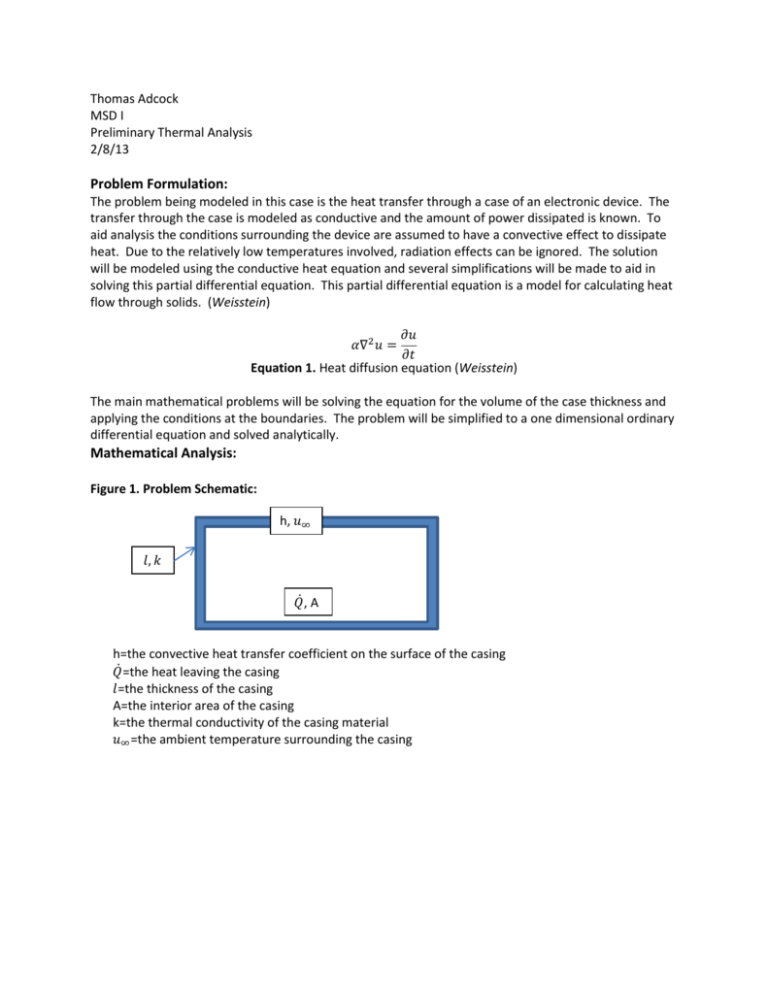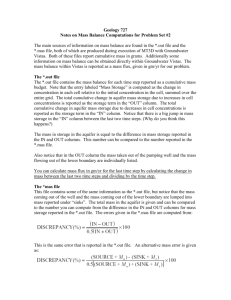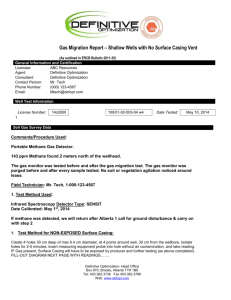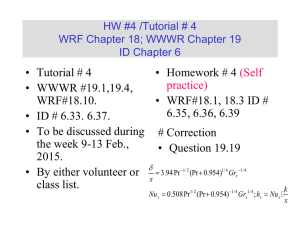Preliminary Thermal Analysis
advertisement

Thomas Adcock MSD I Preliminary Thermal Analysis 2/8/13 Problem Formulation: The problem being modeled in this case is the heat transfer through a case of an electronic device. The transfer through the case is modeled as conductive and the amount of power dissipated is known. To aid analysis the conditions surrounding the device are assumed to have a convective effect to dissipate heat. Due to the relatively low temperatures involved, radiation effects can be ignored. The solution will be modeled using the conductive heat equation and several simplifications will be made to aid in solving this partial differential equation. This partial differential equation is a model for calculating heat flow through solids. (Weisstein) 𝜕𝑢 𝜕𝑡 Equation 1. Heat diffusion equation (Weisstein) 𝛼∇2 𝑢 = The main mathematical problems will be solving the equation for the volume of the case thickness and applying the conditions at the boundaries. The problem will be simplified to a one dimensional ordinary differential equation and solved analytically. Mathematical Analysis: Figure 1. Problem Schematic: h, 𝑢∞ 𝑙, 𝑘 𝑄̇ , A h=the convective heat transfer coefficient on the surface of the casing 𝑄̇ =the heat leaving the casing 𝑙=the thickness of the casing A=the interior area of the casing k=the thermal conductivity of the casing material 𝑢∞ =the ambient temperature surrounding the casing Analytic solution for one dimensional steady state model: The governing equation for the heat transfer problem is the heat conduction equation: 𝜕𝑢 𝛼∇2 𝑢 = 𝜕𝑡 Equation 1. Heat diffusion equation (Weisstein) Expanding this equation gives: 𝜕2𝑢 𝜕2𝑢 𝜕2𝑢 𝜕𝑢 𝛼 ( 2 + 2 + 2) = 𝜕𝑥 𝜕𝑦 𝜕𝑧 𝜕𝑡 Equation 2. Expanded heat diffusion equation This equation does not include the terms to account for heat generation within the material. α is the 𝜕𝑢 thermal diffusivity of the material. Because the solution needed is for steady state, 𝜕𝑡 is assumed to be 0. This places the system in equilibrium. 𝜕2𝑢 𝜕2𝑢 𝜕2𝑢 𝛼 ( 2 + 2 + 2) = 0 𝜕𝑥 𝜕𝑦 𝜕𝑧 Equation 3. Steady state heat diffusion In order to make this equation solvable, the model is simplified to a one dimensional model. This will for a useful approximation because the areas of the sides of the casing are assumed to be far larger than the casing thickness. For the particular device being analyzed, this is a valid assumption. In the case of this assumption the temperature does not vary in the directions perpendicular to the material thickness. 𝜕𝑢 𝜕𝑢 = =0 𝜕𝑦 𝜕𝑧 Equation 4a. Infinite plate approximation assumptions Differentiating these gives the ability to simplify the equation to a form that is solvable analytically using what we have done in classes so far. 𝜕2𝑢 𝜕2𝑢 + =0 𝜕𝑦 2 𝜕𝑧 2 Equation 4b. Differentiated infinite plate approximation assumptions Plugging these in to the original expanded equation gives: 𝜕2𝑢 )=0 𝜕𝑥 2 Equation 5a. 𝛼( The thermal diffusivity of the material will cancel out of the governing equation, but the material properties will be brought in while applying the boundary conditions. It is however assumed to be constant and must not vary within the material for this model to be valid. This gives the governing equation that will need to be solved. 𝑑2 𝑢 =0 𝑑𝑥 2 Equation 5. Equation for simplified one dimensional model This homogenous second order ordinary differential equation can now be solved. 𝑢 = 𝑒 𝑟𝑥 𝑑𝑢 = 𝑟𝑒 𝑟𝑥 𝑑𝑥 𝑑2 𝑢 = 𝑟 2 𝑒 𝑟𝑥 𝑑𝑥 2 𝑟 2 𝑒 𝑟𝑥 = 0 𝑟2 = 0 𝑟 = 0 (𝑟𝑒𝑝𝑒𝑎𝑡𝑒𝑑 𝑟𝑜𝑜𝑡𝑠) 𝑢 = 𝐴𝑒 0𝑥 + 𝐵𝑥𝑒 0𝑥 = 𝐴 + 𝐵𝑥 Equation 6. General Solution In order to specify the flux conditions at the boundaries, the mathematical definition of heat flux is defined as: 𝜕𝑢 𝜕𝑥 Equation 7. Heat Flux (Peles 9) 𝑞𝑥 = −𝑘 k is the thermal conductivity of the material. For the inner surface (x=0), the flux is specified at a rate that corresponds to the heat dissipation needs of the electronics contained within the device. In this case 𝑄̇ is the heat expelled by the electronics and A is the inner area of the case. This assumes uniform dissipation of heat through the case. This assumption is due to the lack of knowledge about the internal configuration of components at this early state of the design. x is the position in the cross sectional thickness of the case material with x = 0 being the inner surface and x = 𝑙 being the outer surface. @𝑥 = 0, 𝑞𝑥 = 𝑞 = 𝑄̇ /𝐴 Equation 8. Inner surface boundary condition For the outer surface the flux is proportional to the difference of the material temperature and the surrounding ambient temperature. The proportionality constant is the convective coefficient h. (eFundamentals) @𝑥 = 𝑙, 𝑞𝑥 = −ℎ(𝑢 − 𝑢∞ ) Equation 9. Outer surface boundary condition (eFundamentals) These two boundary conditions can now be used to solve for the unknown constants in the previously found solution. 𝑢 = 𝐴 + 𝐵𝑥 Equation 6. General Solution In order to work with the flux terms which use the x derivative of the temperature u the solution is differentiated by x. 𝑑𝑢 =𝐵 𝑑𝑥 Equation 10. Differentiated general solution The inner boundary condition (Equation 8) can now be applied to the differentiated general solution (Equation 10) and one of the constants, B, solved for. 𝑞𝑜 = 𝑞𝑥 = −𝑘 𝑑𝑢 = −𝑘𝐵 𝑑𝑥 −𝑞0 𝑘 Equation 11. Solution for B 𝐵= Next the outer boundary condition (Equation 9) is applied to the outer surface of the case. 𝑑𝑢 = 𝑞𝑥 = −ℎ(𝑢 − 𝑢∞ ) 𝑑𝑥 Equation 12. Applied outer boundary condition @ 𝑥 = 𝑙, −𝑘 𝑑𝑢 Putting in the known variable, 𝑑𝑥 and its value, B and the previously found solution for B, the left hand side of the equation can be put in terms of known variables. −𝑘 𝑑𝑢 −𝑞0 = −𝑘𝐵 = −𝑘 ( ) 𝑑𝑥 𝑘 −𝑞0 −𝑘 ( ) = −ℎ(𝑢 − 𝑢∞ ) 𝑘 Next, the solution for u is plugged in to the previous equation −𝑞0 −𝑘 ( ) = −ℎ(𝐴 + 𝐵𝑥 − 𝑢∞ ) 𝑘 The specified value of x=l along with the solved value of B are then plugged in. −𝑞0 −𝑞0 −𝑘 ( ) = −ℎ (𝐴 + ( ) 𝑙 − 𝑢∞ ) 𝑘 𝑘 Now A can be solved for in terms of known variables. 𝑞0 𝑞0 𝑙 + + 𝑢∞ ℎ 𝑘 Equation 13. Solution for constant A 𝐴= This can now be put the solution for constants A and B (Equations 13 and 11) in to the general solution to get the solution for the specified boundary conditions. 𝑞0 𝑞0 𝑙 𝑞0 + + 𝑢∞ − 𝑥 ℎ 𝑘 𝑘 Equation 14. Solution for model 𝑢= 𝜕2 𝑢 𝜕2 𝑢 For modeling more complex geometries, the terms 𝜕𝑦2 and 𝜕𝑧2 can be left in the governing equation. This leaves a partial differential equation that can be used to model two or three dimensional systems. One way that this can be solved for numerically is using finite elements or finite differences. This works well for more difficult to model geometries since analytical solutions can often be very complicated or can not be found. In this case the boundary conditions for flux and convection are set along the geometry boundaries. Assumed Values for Key Parameters: 𝑊 k =.17𝑚∗𝑘 (professionalplastics) 𝑙 = .003m A = .0388 m2 𝑄̇ = 1W to 2W 𝑄̇ 𝑊 𝑊 𝑞0 = = 25.8 2 𝑡𝑜 51.5 2 𝐴 𝑚 𝑚 𝑊 𝑊 h=5𝑚2 ∗𝑘 to 25 𝑚2 ∗𝑘 (Engineering Toolbox) Quantitative outcome of model: Worst Case: 𝑊 𝑊 51.5 2 51.5 2 ∗ .003𝑚 𝑞0 𝑞0 𝑙 𝑞0 𝑚 𝑚 𝑢= + + 𝑢∞ − 𝑥 = + + 40℃ = 51.2℃ 𝑊 𝑊 ℎ 𝑘 𝑘 5 2 . 17 𝑚∗𝑘 𝑚 ∗𝑘 Best Case: 𝑊 𝑊 25.8 2 25.8 2 ∗ .003𝑚 𝑞0 𝑞0 𝑙 𝑞0 𝑚 𝑚 𝑢= + + 𝑢∞ − 𝑥 = + + 40℃ = 41.48℃ 𝑊 𝑊 ℎ 𝑘 𝑘 25 2 . 17 𝑚∗𝑘 𝑚 ∗𝑘 Equation 18. Temperature at inner surface Conclusion: Even in the worst case scenario, the temperature inside the case is only 11C above ambient. For more lenient conditions the difference drops to 1.5C. Overall it does not appear that there will be cooling issues with the device. Works Cited: "Air Properties." EngineeringToolbox.com. Engineering Toolbox, n.d. Web. 11 Jan. 2013. <http://www.engineeringtoolbox.com/air-properties-d_156.html>. "Laminar Forced Convection Over an Isothermal Plate." EFundamentals. EFunda Inc., n.d. Web. 11 Jan. 2013. <http://www.efunda.com/formulae/heat_transfer/convection_forced/isothermalplate_lamflow.cf m>. Peles, Yoav. "Chapter 2: Heat Conduction Equation." Nchu.edu.tw. Nchu.edu.tw, n.d. Web. 11 Jan. 2013. <http://wwwme.nchu.edu.tw/Enter/html/lab/lab516/Heat%20Transfer/chapter_2.pdf>. "Thermal Properties of Plastic Materials." Professionalplastic.com. Professional Plastics, 10 Dec. 2008. Web. 11 Jan. 2013. <http://www.professionalplastics.com/professionalplastics/ThermalPropertiesofPlasticMaterials.pdf >. Weisstein, Eric W. "Heat Conduction Equation." Wolfram Math World. Wolfram, n.d. Web. 11 Jan. 2013. <http://mathworld.wolfram.com/HeatConductionEquation.html>. http://www.engineeringtoolbox.com/convective-heat-transfer-d_430.html









